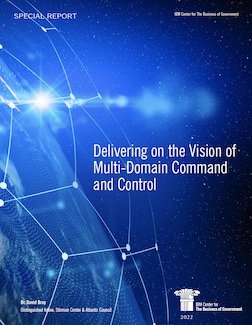
Delivering on the Vision of Multi-Domain Command and Control

Across the defence and national security landscape, all involved are grappling with the speed of technological change and the deteriorating strategic context. Everyone, from capability development to planning to operations, is aware that Western Allies no longer have a technological advantage over peer adversaries. This means to win the future battle, we must be focused on gaining situational advantage—making decisions better and faster than the enemy. Multi-Domain Command and Control (MDC2) is focused on gaining that decision superiority. It is the strategy for integrating and coordinating command and control operations simultaneously across air, land, sea, space, cyber, and electromagnetic domains.
Dr. David Bray has expertly gathered the thoughts and insights of a diverse range of leaders from defence, industry, and academia on how well that strategy is being implemented.
By defining the need for MDC2 in context of the human flaws and irrationality in chaotic, uncertain, ambiguous circumstances—as well as the ability of the adversary to contribute to that uncertainty and the inherent flaws of any technological system and its processes—David elevates the discussion beyond any single challenge. This is vital because the modern battlespace is anything but homogenous. It is a seething mass of digital infrastructure that includes edge assets, public/private clouds, embedded weapons systems software, and a host of Internet of Things (IoT)—all built separately, over a long period of time and for different purposes.
To solve for the challenges of MDC2, this paper outlines a range of action-oriented steps to be taken. Each step supports one or both of these top-line statements:
- Strong and gifted commanders, at all levels, must remain at the centre of the solution. They must learn, and continually relearn, how to take best advantage of the technology available to them and to inform development of the next generation of systems.
- Only a hybrid cloud architecture can provide a consistent, standards-based approach to development, security, and operations. It’s a smarter architecture that allows for workload portability, orchestration, and management across multiple environments.
For defence and national security—when the mission is this critical—agility and flexibility is everything. Such a complex undertaking doesn’t mean a lack of planning or being unstructured. It means taking the right approach to avoid being locked in and unable to respond to a changing environment.



